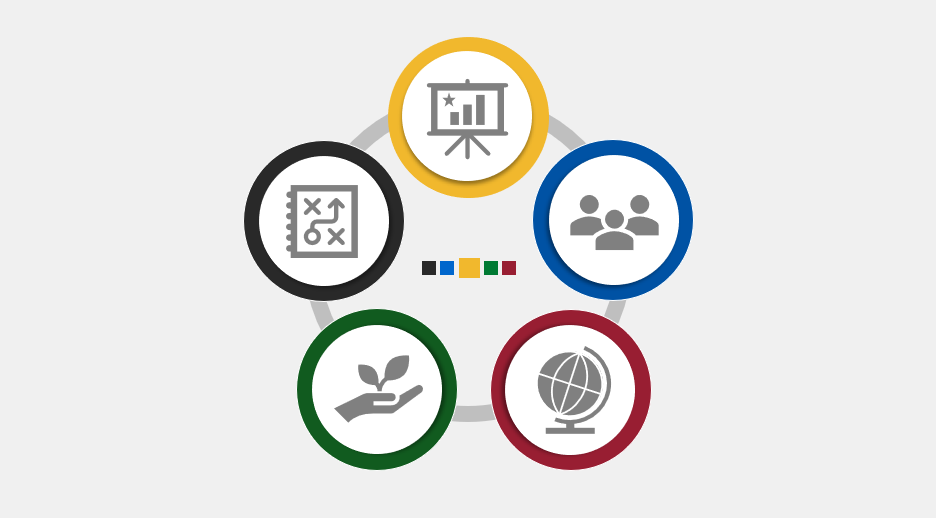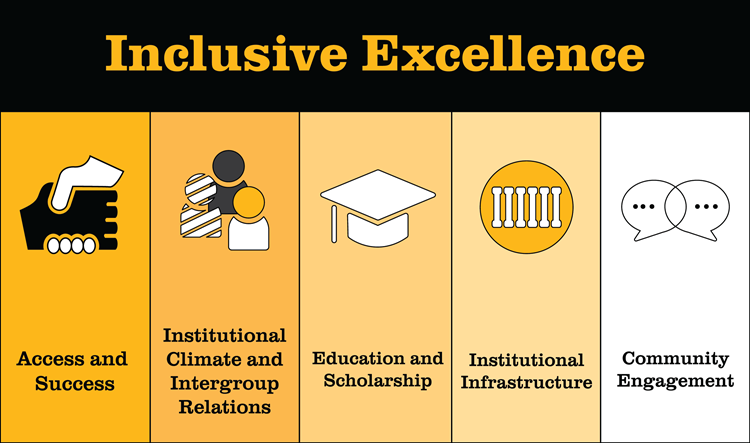Leaders have a responsibility to demonstrate excellence in their own pursuit of continuing to harness their skills in leading people. Investing time in professional development for yourself is investing in a vibrant future for our organization. At the same time, the university's values of respect, responsibility, discovery and excellence guide us to embrace and encourage inclusivity in all that we do.

Leader Competency Model
The Leader Competency Model helps define what effective leadership looks like at the University of Missouri System. This model outlines “how” one successfully does their job, and the competencies are used in a variety of programs. This model is a helpful tool to assess where you are meeting expectations and where you need to grow.
Leaders are encouraged to engage in leadership development programs, trainings, and review other resources to be effective throughout their career with Mizzou.
Staff Leadership Development Programs
- Dr. Elson S. Floyd Administrative Leadership Development Program (ALDP): Professional Development for senior-level leaders
- Organizational Perspectives and Leadership (OPAL): Professional development program for mid-level leaders
- Series on Leadership Essentials (SOLE): Series intended to help build and refine practical skills for people leaders
Faculty Leadership Development Programs
MU is committed to the development of its faculty across the career span and in a wide variety of sectors. Visit the Office of the Provost's MU Development Programs webpage for faculty members.
Percipio Resources
The following content collections within Percipio can help support your ongoing effectiveness as a leader:

Development and Training
Information and Handouts
SWOT Analysis
| Internal factors | Strengths: Identify what you as a leader are doing well (everyone has strengths). | Weaknesses: Identify what your weaknesses are as a leader (everyone has weaknesses). |
|---|---|---|
| External factors | Opportunities: Identify what external factors may provide opportunities for your success as a leader. | Threats: Identify what external factors may weaken or be a constraint for your success as a leader. |
SMART Goals
- Specific: Define the goal with specifics including who is involved, what deliverables or achievements are expected, where will the work be done, why is this a goal, and what constraints are there to achieving the goal?
- Measurable: How will progress and success be measured?
- Attainable: Is the goal reasonable enough to be accomplished?
- Relevant: Is the goal relevant with the organization's mission, vision, values? Is it aligned with the organization’s goals and priorities?
- Timely: Goals should be time-bound, establish a sense of urgency and expectation.
Examples:
- "Over the next six weeks, I will improve my conflict resolution skills by completing weekly training in Percipio."
- "By the end of the year, I will increase the percentage of vacancies filled by 10% by actively participating in recruiting, reviewing applications daily, and conducting interviews within 5 days of application review."
- "By the end of the year, I will decrease turnover of high-performing employees by 20%. To achieve this, I will increase internal communications and focus on talent retention, ensuring employees are happy with the atmosphere and engaged in high-priority initiatives."
Time Management and Priority Matrix
Adapted from Covey, Stephen (1989). The 7 Habits of Highly Effective People. Simon & Schuster, USA.
| Urgent | Not urgent | |
|---|---|---|
|
Important Contributes to the achievement of goals and priorities |
Quadrant I:
Examples: Crises; pressing problems; deadline-driven work such as hiring, providing employee feedback and conflict resolution |
Quadrant II:
Examples: Planning, preparing and strategizing such as developing staffing plan, organizational analysis and succession planning |
| Not important |
Quadrant III:
Minimize or delegate |
Quadrant IV:
Eliminate |